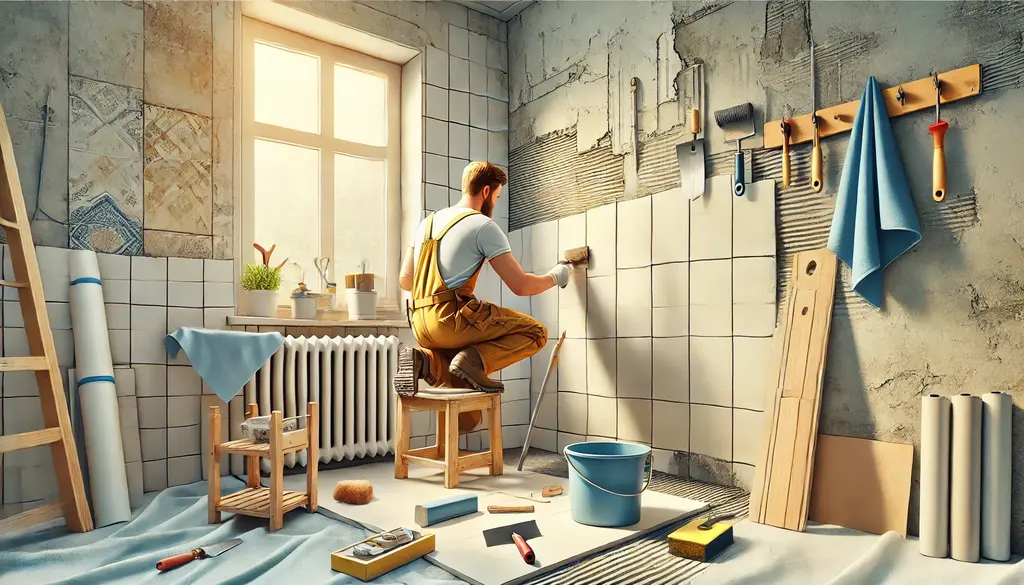Tiling can transform the look and feel of a room, adding style and function to spaces like bathrooms, kitchens, and entryways. However, the key to a durable and professional-looking tile job lies in the preparation of the wall surface. No matter how stunning your tiles are, they won’t adhere properly or stay in place unless the wall beneath them is prepped to perfection.
In this guide, we’ll walk you through everything you need to know about preparing a wall for tile. Whether you’re working with drywall, plaster, or even existing tile, the steps below will help you get the job done right.
You may also like this: How to Fix a Door that Won’t Latch?
Why Wall Preparation Matters?
Before diving into the practical steps, it’s essential to understand why wall preparation is so critical. Tiles need a clean, level, and stable surface to bond securely. Uneven or dirty walls can cause tiles to crack, shift, or pop off over time. Proper preparation also ensures a smooth finish, helping you avoid issues like lippage (uneven tile edges) or gaps in your grout lines. In short, preparation is not just a formality; it’s the foundation of a successful tiling project.
Tools and Materials You’ll Need
Before starting, gather all the necessary tools and materials. Having everything on hand will save you time and ensure you don’t cut corners. You’ll need basic tools like a trowel, sandpaper, and a sponge, as well as specific materials such as tile adhesive and a cleaning agent like TSP (trisodium phosphate). Depending on the condition of your wall, you may also need a spackling compound for repairs and a primer for sealing the surface. Preparing well at this stage sets you up for a smooth process.
Safety First: Precautions You Must Take
Tiling work involves tools, chemicals, and dust, all of which can pose safety hazards. Always turn off power to any outlets or light switches on the wall you’re working on. Use a non-contact voltage tester to ensure no electricity is running through exposed wires. Wear protective gear, including gloves, safety glasses, and a dust mask, to protect yourself from irritants like cleaning agents and airborne particles. Finally, cover surrounding areas with drop cloths or plastic sheeting to protect them from dust, debris, and spills.
Assessing Your Wall Surface
Before you can prep your wall, you need to assess its current condition. Walls come in various forms, including drywall, plaster, and even existing tile. Each type requires a slightly different approach. Check for any loose or peeling paint, holes, cracks, or uneven surfaces. These imperfections must be addressed to create a solid foundation for the tiles. If your wall has wallpaper, it must be completely removed, as tiles won’t adhere properly to such surfaces. Glossy surfaces also need to be sanded down to create a suitable bonding texture.
Cleaning the Wall: The Foundation of Preparation
Cleaning is one of the most critical steps in wall preparation. Dirt, grease, and dust can interfere with the adhesive’s ability to bond with the wall. Start by wiping down the wall with a damp cloth to remove loose debris. For tougher grime, especially in kitchens and bathrooms, use a cleaner like TSP or an ammonia-based solution. Scrub the wall thoroughly, paying extra attention to greasy spots or areas with mold. Rinse the surface with clean water and allow it to dry completely before moving on to the next step.
Repairing and Smoothing the Wall
Once the wall is clean, inspect it for any damage. Holes, cracks, and dents must be repaired to create an even surface. Use a spackling compound or filler to patch up imperfections, and let it dry completely. Afterward, sand the repaired areas to make them flush with the rest of the wall. If the wall is significantly uneven, consider applying a skim coat of joint compound to level it out. This extra step may take some time, but it will ensure a professional finish.
Dealing with Specific Wall Types
Different wall types require tailored preparation methods:
- Drywall: If you’re working with new drywall, it’s essential to seal it with a primer. This prevents the drywall from absorbing moisture from the adhesive, ensuring a strong bond. For painted drywall, sand down any glossy areas and remove flaking paint.
- Plaster Walls: Older plaster walls may have cracks or loose sections. Repair these areas with plaster filler and reinforce them with mesh tape if necessary. Make sure the plaster is dry and stable before tiling.
- Existing Tile: Tiling over existing tiles is possible but requires extra preparation. Clean the surface thoroughly to remove any grease or soap scum. Then, sand the tiles to create a rough texture that will help the adhesive bond. If the old tiles are uneven, consider applying a leveling compound.
Priming the Wall
Priming is an often-overlooked but vital step in wall preparation. A good primer seals the surface and prevents moisture from seeping into the wall, which can weaken the adhesive. Choose a primer that is compatible with both your wall type and your adhesive. Apply it evenly using a brush or roller, and allow it to dry completely before proceeding. Skipping this step can result in poor adhesion and compromised tile installation.
Final Preparations Before Tiling
Now that your wall is clean, smooth, and primed, it’s time for the final checks. Measure the wall to determine how many tiles you’ll need, and purchase extra tiles to account for cuts and potential breakage. Typically, buying 10–20% more tiles than calculated is a good rule of thumb. Lay out the tiles on the floor to plan your pattern and ensure you’re happy with the design. Make sure you have the right adhesive for your wall type and tile material—consult product labels or a professional if you’re unsure.
Preparation is Key to Success
Taking the time to properly prepare your wall for tile is an investment in the quality and longevity of your project. A clean, level, and stable surface ensures your tiles will adhere securely and look their best. By following the steps outlined in this guide, you’ll set yourself up for a smooth and successful tiling job. Remember, the effort you put into preparation will pay off with stunning, durable results that you can enjoy for years to come. So roll up your sleeves, gather your tools, and get started—the perfect wall awaits!

